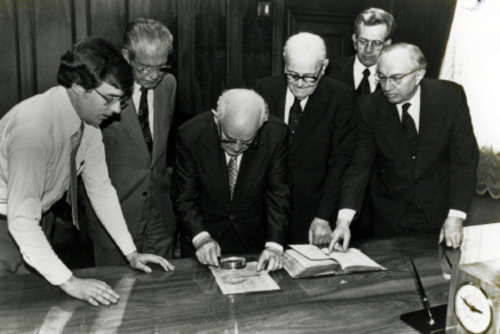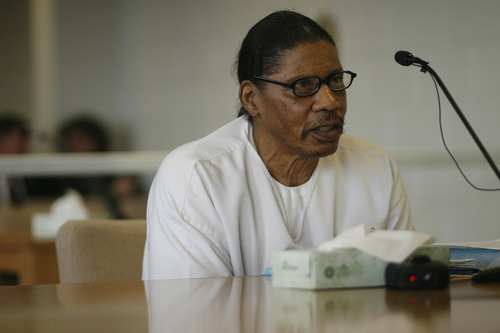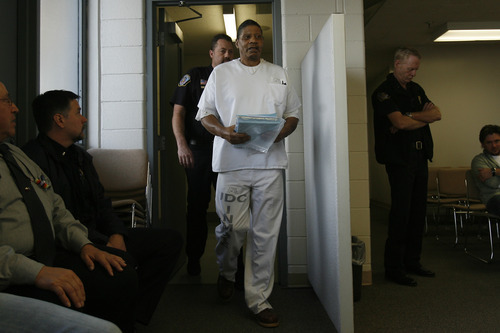This is an archived article that was published on sltrib.com in 2012, and information in the article may be outdated. It is provided only for personal research purposes and may not be reprinted.
When his death penalty was set aside in 1985, replaced with a new sentence of five years to life, ElRoy Tillman believed he might someday walk out of the Utah State Prison a free man.
A new man. Lesson learned. Debt paid. Time served — 30 years so far for killing a man in 1982, a crime Tillman denies committing.
But three years ago, the Utah Board of Pardons and Parole settled on the words "and which may be life" in his sentence, and decided that Tillman will never leave prison.
Tillman appealed the decision on constitutional grounds, arguing the board gave him an "illegal natural life prison sentence"and did not have the right to take away his possibility of parole.
"I'm just saying that the board is out of control," said Tillman, now 78, during an interview Friday at the prison. "They're giving people sentences that are not even on the books. ... The board thinks they're a court and want to retry the crime."
But two federal courts have since upheld the board's right to issue such decrees.
"I would think, having gone through the judiciary process, [defendants] know when they are sentenced that if they have a 'life top' they have the potential to be in prison indefinitely," said Jim Hatch, board spokesman, later adding, "unless the board intervenes, essentially exercising our clemency power, and releases him to parole."
Kent Hart, executive director of the Utah Association of Criminal Defense Lawyers, said many defendants are poorly educated and uninformed and during their sentencing hearings, they hear one thing: "There is a possibility of parole."
"If that is taken away, I am sure they would feel like they are misled or that it's unfair," Hart said.
The fact is, the board is handing out more of these sentences. There are 108 inmates serving board-issued natural life sentences, according to the Utah Department of Corrections. Of those inmates, 73 — or 68 percent — received a natural life decision within the past four years. The board has made 22natural life decisions so far this year, about twice as many as in each of the past four years.
Tillman, who moves, talks and looks like a man decades younger, spoke calmly, focused on the legal fight he is still waging rather than what appears to be an unalterable future. He works out at the gym, has a job cleaning the visitor's room where Friday's interview took place, and talks by telephone to his four adult children "all the time."
Back in the 1980s, the board worked differently, he claims, but the "whole procedure is changing."
"Now, no one is putting the board under check," Tillman said, a stack of his petitions resting nearby on the table. Hours after the interview, Tillman lost one more battle when the Utah Supreme rejected his request that he either be given a new trial or have his sentence reduced.
A "crushing" blow •Utah has a unique sentencing structure found nowhere else in the country. Judges and juries determine a defendant's innocence or guilt and, if convicted,hand down an indeterminate sentence as set by lawmakers. If a defendant is sent to prison, it is the parole board that ultimately decides how much retribution to exact and whether redemption is possible.
The inmates receiving natural life sentences from the board — a small fraction of the prison population — tend to be murderers, rapists, pedophiles and repeat offenders.
They include some of Utah's most notorious criminals: forger Mark Hofmann, who made bombs that killed Steven Christensen and Kathy Sheets in 1985; Walter Kelback, who with Myron Lance, killed six people in Salt Lake City over a five-day span in 1966; rapist Ronald D. Easthope, who admitted to nine attacks in the Sugar House area and was sent to prison in 1971; and Jacob Ethridge, who killed two Ogden prostitutes in 2008, was sentenced in 2010 to two consecutive 20 to life terms, and learned in January he'd never leave prison.
Some inmates and their relatives say a natural life sentence comes as a "crushing" and unexpected blow, often after years of incarceration in which a shot at freedom was the only thing that keeps a felon going.
"It hit him like a ton of bricks," said Vickie Hopson of her son, Jason Brett Higgins, who learned in April that he would spend the rest of his life in prison for raping eight females ranging in age from 14 to 52.
Higgins was 23 in 1998 when he was convicted and given a 15-years-to-life sentence.
"He was the first one to say he belonged there and he did do bad things and was where he needed to be now," said Hopson, 60. But, "he has done a lot of good and yet they wouldn't acknowledge [any mitigating factors] except that he has a family that comes to see him. ... We never expected it to be a parole hearing, but we did expect them to say come back in five, seven, years and we'll talk to you again. "
During his incarceration, Higgins, now 38, has completed an associate degree, gone through treatment and has worked two jobs — creating audio books for the blind and sewing inmate clothes.
Weeping, Hopson adds: "What do you do with yourself when you have no hope for anything?"
That, as it happens, is exactly how one of Higgins' victims once felt. In the years after Higgins attacked her, Rebecca Mills' life spiraled out of control. At his hearing before the board in March, Mills said Higgins had given her a "life sentence." He deserved the same, she said.
The most heinous • Life sentences used to be rare, said Marie Gottschalk, a political science professor at the University of Pennsylvania.
"And even then, those with a life sentence, if they stayed low and had a reasonably good record, they would be out in 15 years or so through paroles or pardons," Gottschalk said. But since the 1970s, "there has been a mushrooming of life sentences that is extraordinary and very different from countries in Europe."
At present, about 140,000 people in the U.S. are serving life sentences — twice the entire prison population in Japan, she pointed out.
Hatch said the board never takes a natural life decision lightly.
"It's fair to say those offenders committed the most heinous crimes we see, and/or continue to pose such a high risk that public safety would be compromised if they were ever released," Hatch said. There is no "pattern or any kind of procedural thing that dictates when that decision gets made," he adds. "It gets made on a case-by-case basis and when the board feels it is a deserved decision."
One case in which the board decided release was warranted: Bob Lee Boog Jr., known as the Capitol Hill rapist, received a sentence of 10-years-to-life after pleading guilty to one count of first-degree aggravated sexual assault. Authorities believe Boog committed 13 rapes and attempted five others between 1983 and 1987.
Boog went to prison in 1988. After 16 years, the board decided Boog had done enough time and in 2003 released him. He will be on supervised parole for the rest of his life, unless his probation officer and the board agree to terminate that supervision.
The wide latitude in decision-making, lengthy waits for rehearings and differences between state statute and a sentencing guideline used by the board adds to confusion of inmates and their families.
Sex offenders, for whom a five-to-life sentence is common, typically come before the board after serving three years, Hatch said. But some inmates spend decades in prison only to learn they'll stay there forever. Most murderers, for instance, serve 22 to 24 years before being eligible for an original hearing before the board.
"Some of them will eventually get a natural life decision, because many of them haven't appeared before the board yet," Hatch said. "When the board orders natural life, then they've set aside the guidelines" because of the heinous nature of an inmate's crime.
Life-long costs • Some inmates say that even when the board stops short of a natural life sentence, it sets unreasonable rehearing dates that have a similar effect.
At his sentencing in 2001, Shayne E. Todd received five-to-life and one-to-15 year terms for murder and being a felon in possession of a weapon. Todd shot and killed his estranged wife during an argument in the parking lot of a Sandy bowling alley in 1999.
At his original hearing before the board in 2010, Todd received a rehearing date in 2029 — a 31-year wait. He is appealing that decision in state and federal courts.
In a letter to The Tribune, Todd, now 41, wrote, "The undisputed facts are the Utah Board of Pardons has been unlawfully acting as a sentencing board, rather than a board of pardons, particularly where it no longer accepts an inmate's good or bad prison behavior in determining his [or] her release date eligibility."
But there is nothing unlawful about it, a point made in the August ruling by the 10th Circuit Court of Appeals in Tillman's case.
Hart said the expense incurred by a growing number of natural life sentences is something else that should be, if not considered, at least understood.
It currently costs the state approximately $3.2 million a year just to house the 108 inmates who now have board-determined natural life sentences, an expense that will grow by at least $30,000 a year, the average annual cost for incarceration, for each additional inmate handed such a term — and possibly more, as these inmates face age-related illnesses before dying in prison.
The average age of inmates at the Utah State Prison with natural life sentences is 56. There are 62 inmates age 55 — the age at which an inmate is considered elderly — or older, with the oldest an 82-year-old sex offender. At least five inmates were in their 20s when the board revoked any chance of parole.
Hart said studies show that permanently revoking parole "may help our sense of justice and retribution, but ultimately it is a waste of money and a waste of human life."
"There are people who are low-risk [re-offenders], who if we were to let them be released, they would not hurt anybody," Hart said. "They've either attained a certain age where the propensity for violence is diminished, largely for biological reasons, or circumstances have changed."
Defendants who commit crimes of passion would fall in that latter category, he said.
Pending appeals • While Tillman's case against the board may have been decided, a number of other inmates have similar appeals pending in state and federal court, which means the issue is likely to be revisited. Stephen Van Dam is among those inmates.
After serving several sentences for rape, burglary and criminal trespass, Van Dam was incarcerated again in 1983, at age 33, after being convicted on at least four counts of aggravated sexual assault and confessing to at least 17 other attacks. He briefly escaped and was returned to prison in 1985.
Van Dam first appeared before the board in 1993, when based on good behavior and treatment, he received a parole date of January 1996 — in error, apparently, since it was revoked a few months later, according to court documents. A rehearing date was set for 2003, where Van Dam once more believed he would get a parole date. Instead, he was told to come back before the board in seven years.
At that 2010 hearing, Van Dam, now 63 and suffering numerous physical ailments, learned he would never be released from prison.
The board cited, in part, the "extent of psychological damage he has caused to an undetermined number of victims," one of whom called him a "monster" during the hearing.
In his appeal petition, Van Dam said the prison promises inmates that completing its "star" rehabilitation programs is a key factor in getting a parole date. He worked, got an education, did therapy, remained discipline free — in short, was a model prisoner — only to have his "expectations" of parole evaporate.
"It's not easy to live in prison and not get in trouble. Prison is a terrible, terrible place," said Molly Prince, a private practice therapist who works with sex offenders. "If you manage to get through prison and do your therapy and work really hard at living those principles ... and you're given some hearings, two or three hearings, and suddenly are told that no matter what you've done, you're not getting out — it feels like you're being resentenced."
In its response to Van Dam, the Utah Attorney General's Office said board decisions can only be reviewed to evaluate fairness of the process followed, not the result. And given Van Dam's "brutal history and numerous victims," it said, the board's refusal to grant him another shot at freedom is reasonable.
Twitter: @Brooke4Trib —
Natural life sentences
Anyone guilty of a first-degree felony — murder, rape, child kidnapping, aggravated burglary, aggravated robbery, arson and possession of a controlled substance with intent to distribute near a school — could later be handed a natural life term by the Utah Board of Pardons and Parole under Utah's sentencing scheme.
One example: According to the board, it has ordered natural life sentences for 25 of the 74 inmates currently imprisoned for aggravated murder; the rest will serve between 25 and 30 years before getting either an original or review hearing or being eligible for parole.
The board has ordered 23 of the 257 inmates convicted of murder to spend the rest of their lives in prison; most — 150 inmates — will serve nearly 21 years before they get an original hearing before the board, when it will determine how much longer they'll serve for their crimes. The board declined to set parole dates for another 41 people, who will serve an average of 25 years before getting a rehearing; 43 have parole or termination dates that will require them to serve close to 22 years before they are eligible for release.
— Source: Utah Board of Pardons, current as of April 26, 2012







